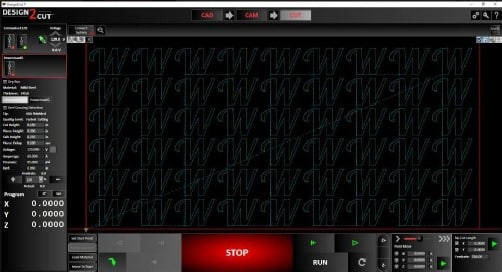I never imagined when I built my first plasma table about 11 years ago that I would be where I’m at today. The table was just a 4×4 and I just intended on making things for myself working on my off road vehicles and miscellaneous projects. And here we are 11 years later and I have a very successful business running.
Getting to this point I have learned a lot along the the way and I hope to share some of this with you to make things easier for you and you can avoid some of the growing pains that I went through. This by no means is a complete guide or list and every jurisdiction has different rules so take this all into consideration.
If you want to get into this and never be a business, that’s great! No problem with that, but just do some hard thinking and really contemplate the reality of it. If you ever think you could start making things and selling them, it’s better to get ahead of the curve and make your hobby a business early rather than later. The turning point for me is when I noticed I was making more money in my plasma cutting business than in my day job. That’s when I knew I had to completely dedicate myself to this business.
Come up with a Name
This is a do it once and do it right thing. Changing things down the road is not easy so pick a name that reflects what your doing is easy to remember and spell and is not already in use by someone else. Remember this name is going to be part of website addresses, email, forms, etc. So making it really long or hard to spell will create problems down the road. Take time here and do it right.
Logo
Branding is the name of the game and it will be part of your website, Facebook page, letter head, invoices and everything else. Picking a logo that is square or round works best because of the design of websites, Facebook and other social media outlets. There are lots of places that will design a logo for you if your not that artistic. One example is fiverr where people offer all kinds of B2B services for about $5 and up. Logo Design, videos, graphics etc.
Making it legit
Once you have your name and logo its time to make it legit and form your business. My recommendation is to skip the sole proprietorship and jump right into forming an LLC AKA Limited Liability Corporation and file as an S-Corp. Say What? Ok if I scared you, no worries, its easy. You can do this all yourself or you can enlist help. Every state is a bit different on all the rules and hoops so I’m not going to get too specific here but there should be guides online for every state just do a little Google search and you can do all of this yourself if you’re up to the challenge. If not, enlist the help of online services like Legal Zoom or look for an accountant or paralegal office near you. Both can usually guide you through this process.
Why an LLC and not Sole proprietor? Its better and safer to separate your personal assets, social security number and other personal ties from the business right off the bat. This has tax advantages as well as legal advantages, should something go wrong down the road. It’s a little extra work in the beginning but once its done its done.
Business License
Once your LLC is setup and you have your tax id number, determine if you need to have a business license for where you operate. This varies from state to state, county to county, and city to city. You want to have a state resale license established, but this is different from a business license. This does have the advantage that if there is an event or fair in the city and you want to have a booth, you’re already a licensed business. As I said this will vary for everyone so check out your location.
Accounting
When you enter the business world, you need to keep track of all your business stuff. You need to have a way to organize and manage it for taxes and everything else. If you do form and LLC, you need to get a separate bank account set up for the business. This keeps business and personal money separate. You can put money into the business and pull money out but you need to track it. That is where accounting software really comes in. I use Quickbooks. Why? Because that is what my tax lady uses. Seriously though, it’s a good program. There are a ton of videos and tutorials online to help you. Having some kind of accounting software is really necessary. Bite the bullet and get going right off the bat. If you log and track everything it can really help you manage expenses and track how you’re doing, as well as guide you in your pricing, helping out when it comes to tax time, getting back as much as possible. Speaking of tax time, as I said I have an account that does my taxes both for personal and business. Necessary? no. But nice? Yes. Almost all of the online tax programs these days have a business version, and they do a really good job of guiding you through the process at tax time.
Invoices / credit cards
As you know we live in an electronic online society these days. As customers ourselves, we expect businesses to deal with us online. Your business should not be any different. Your accounting software will be able to generate invoices, but depending on which software it is and how it’s setup, it can be different than in person. With PayPal you can email a customer an invoice, they can pay with a credit card if they do not have a PayPal account, or use their account if they are set up with PayPal already. You can then send the funds straight to your bank account without ever having to touch a credit card or cash. PayPal also offers a credit card reader so that you can accept credit cards in your shop, at a craft fair, or virtually anywhere. This is definitely a must in our society.
This service is not free. Small and large business alike, we all pay fees to the credit card processing companies for this convenience. The fees vary and usually are a percentage of the amount charged. It varies but is usually around 2-3%. I consider this a cost of doing business and a convenience fee. Factor this into the cost of your goods or services if you need to.
Marketing
Once you have all of the above handled, it’s time to market you business. Check out our page on Marketing your Plasma business. As much of a digital society that we are, the good old paper business card is still a mainstay. I really like using Vista Print online for my business cards. They can also do your banners, magnet vehicle signs, novelty items and a host of other services for a very reasonable price.
Getting Business
Usually once you make the step to become a business, you need business. You now have overhead to pay for; the accounting software, credit card fees, business license, website costs, etc. That overhead that you now have, when you made the switch from Hobby to Business, needs to be covered in your “Shop hourly rate”. You’re running a business now, not a hobby. You did not make this jump to lose money, at least not in the long run.. So charge a fair price that allows you to continue moving forward. When I started out, I did not pay myself a salary because the Plasma Cutting was a side business. Instead, any profits the business made were reinvested in the company in the form of new or better tools and equipment.
A good website and smart marketing on social media will do wonders for bringing business to you, but do not underestimate word of mouth. Quality work at a fair price is one of your biggest allies in bringing in customers. Depending on where you are located and the clientele that you have, you can solicit business as well. Talk to sign shops that mostly do plexi or vinyl signs. Sometimes customers want metal and you could be a resource. Meet your local fence companies. Ornamental designs are always a hit on fences, and you can cut them. Get to know your local building contractors, custom base plates, brackets and a host of other things are now something you can provide.
Competition
If there is a lot of competition in your area, find a niche or style that sets you apart, always take the high road and maintain good ethics. There is more than enough work to go around, you just have to innovate to find it.
Summary
The first few months can be rough and profits are usually low or non-existent, but stick in there. If you setup with a strong stable foundation, avoid the common pitfalls, and maintain a positive reputation, don’t give up. You will prevail.



